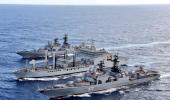The navy finds itself fighting for relevance, with navy planners lamenting that its share of the budget has dropped dramatically.
Ajai Shukla reports.

Exactly 49 years ago, on December 4, 1971, the Indian Navy wrote itself into relevance as a factor in Indian war planning by launching a spectacularly successful seaborne raid on the Pakistan navy's main base in Karachi.
Prior to that, India's smallest service had no role in any of the three wars India had fought, including the 1947-1948 war with Pakistan, the 1962 war with China and again in the 1965 war with Pakistan.
But in 1971, India's far-sighted navy chief, Admiral S M Nanda, understood that, if the navy remained on the margins, it would cease to be relevant, and its budget slashed to the point where warship modernisation would be impossible.
Already, after the 1962 War, the navy's share of the defence budget -- which had risen from four per cent in 195019-51 to nine per cent in 1956-5197, and 12 per cent in 1959-1960 --plummeted back to four per cent in 1963.
Admiral Nanda knew that a spectacular strike would bring the navy front-and-centre. He planned for the 25th Missile Boat Squadron, which comprised of three Soviet-origin Vidyut-class missile boats -- INS Nipat, INS Nirghat and INS Veer -- to attack Karachi in what was code-named Operation Trishul.
Quietly sailing from Gujarat a day earlier and attacking Karachi at dusk on December 4, the three missile boats took the Pakistan navy completely by surprise.
Using their Styx surface-to-surface missiles to lethal effect, they sank the destroyer, Pakistan navy ship Khaibar, a minesweeper, PNS Muhafiz; ammunition vessel, Venus Challenger; and badly damaged the destroyer, PNS Shah Jehan.
Then INS Nipat fired its missiles at the Kemari oil storage facility in Karachi harbour, setting it ablaze and causing a national fuel shortage for Pakistan all through the war.
Admiral Nanda was to call it the 'biggest bonfire in the Arabian Sea'.
Four days later, the navy followed up Operation Trishul with the similar Operation Python. So demoralised was the Pakistan navy that it withdrew its warships into harbour and unloaded their ammunition to prevent explosions in the event of further Indian war attacks.
The Indian Navy celebrates December 4, the anniversary of Operation Trishul, as Navy Day each year. And the navy features in every history of the 1971 conflict.
This was a classic example of a tactical operation that had strategic consequences. To this day, Pakistan's security calculus is complicated by having to defend a coastline of 1,046 kilometres in addition to its 2,912 kilometre-long land frontier with India.
Yet, 49 years after Operation Trishul, the navy finds itself fighting for relevance, even though it is the main point of interface with major defence partners such as the US, whose common interests with India are in the waters of the Indo-Pacific.

Navy planners lament that its share of the budget has dropped dramatically. Admiral Karambir Singh, the chief of the naval staff, stated last Navy Day: 'The Navy's share of the defence Budget has declined from 18 per cent in 2012 to approximately 13 per cent.'
This decline has forced the navy to downscale its long-term Maritime Capability Perspective Plan for 2012-2027. Instead of fielding 200 warships by 2027 as earlier planned, the navy's vice chief, Vice Admiral G Ashok Kumar now puts that figure at 'about 175'.
On Thursday, Admiral Singh gamely explained that the navy would compensate for the shortage of warships by giving them more 'bang for the buck, through (digital) networking and introducing unmanned systems.'
Meanwhile, the navy's most iconic plan, to build a third aircraft carrier this decade, has run into opposition from the tri-service boss, Chief of Defence Staff General Bipin Rawat.
In February, General Rawat got embroiled in the longstanding naval debate over whether the navy's primary striking power should be through aircraft carriers or submarines. The CDS threw his weight behind submarines, stating that a carrier requires a battle group of five-to-ten other warships for its protection in war.
As the navy was quick to point out, the corvettes, frigates and destroyers in a carrier battle group are not there to protect the aircraft carrier, but to add to the strike power of the force in all four dimensions of naval warfare -- anti-submarine, anti-ship, anti-shore and air defence.
In May, General Rawat weighed in again against the aircraft carrier, publicly stating that India's military is not an expeditionary force and that it only has 'to guard and fight only along our borders, and, of course, dominate the Indian Ocean Region.' A carrier, the CDS stated, can be 'knocked off by missiles'.
On Thursday, the navy chief pulled no punches in arguing for a power projection capability within the navy, through a third aircraft carrier.
'For an aspirational country like India, which wants to become a $5-trillion economy, you have to be able to (project power) outwards. We cannot be a navy that is tethered to the shore,' Admiral Singh said.
He also spoke for a more credible submarine capability through the early conclusion of Project 75-I, which envisages building six more conventional submarines, with 'air independent propulsion', in India.
'The (Project 75-I) submarine programme is on track. We have shortlisted (the foreign and Indian agencies participating). The programme is going up for approval to the defence ministry and then we will issue a Request for Proposals (tender),' Admiral Singh stated.
Ultimately, like the Rs 50,000 crore project for a third aircraft carrier, the Rs 50,000 crore Project 75-I will depend upon the availability of funds for the navy.
Unless the defence budget itself is increased substantially, or the navy's share of the budget goes up, both these projects are likely to remain financially unviable.









